Scoutmaster Musings
Archives:
2023 2022 2021 2020 2019 2018 2017 2016 2015 2014 2013 2012 2011 2010 2009 2008 2007 2006 2005
Bob the Ranger
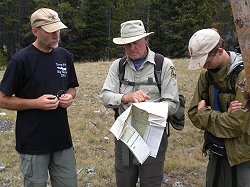 When people are concerned primarily with their own advancement, enjoyment, wealth, and success, even at the expense of others, conflicts are bound to occur. It's common to hear about swindles, robberies, and other similar crimes. We have people in business continually trying to bend or bypass the rules and laws in order to take advantage of someone else.
When people are concerned primarily with their own advancement, enjoyment, wealth, and success, even at the expense of others, conflicts are bound to occur. It's common to hear about swindles, robberies, and other similar crimes. We have people in business continually trying to bend or bypass the rules and laws in order to take advantage of someone else.To combat this greed, there are new regulations constantly being created. And, people trying to find new ways around them.
These regulations are enforced and there are penalties if you get caught. If there was no enforcement then many people would ignore them.
This is where many people get their view of policemen - people that enforce laws and imprison bad guys. But, that is a small part of the service they provide. They also perform first aid, help lost kids, provide information, make people feel safe, and many other good deeds.
In the wilderness, you might meet a wilderness ranger, employed by the US Forest Service or other land management agency. These rangers are similar to police. They have the duty to enforce regulations, such as group sizes, campfire use, and campsite locations. Many people think of them only in this role - the role of enforcer - and therefore are apprehensive when meeting one.
Unfortunately, some of the rangers also see themselves mainly in this role and they promote that confrontational view of the community. I've met a couple of these rangers over the years. They let you know that it's "their" wilderness and your group is visiting, and by gosh you'd better watch yourselves. These rangers must have the worst job in the world - being out in beautiful country but not able to enjoy it because they are too busy looking for "trespassers" causing problems.
On the other hand, there are some rangers like the one I talked to on both my treks this past month. His name is Ranger Bob and he embodied what I think a ranger should be. He checked our permit to make sure we were 'legal'. He asked us our plans and how our hike was going. He pointed out a couple good sites to camp that were well away from other groups - in a way that I understood he wanted us to use them, but not in a forceful authoritarian way. Then, he let me know that fires were prohibited in the wilderness and he appreciated me bringing young guys out to enjoy the countryside.
A few minutes after he left us to continue his hunt for illegal fire sites, he came back and asked if we were interested in viewing some wildlife. He then led us around a small stand of trees to see two moose in the creekbed - moose that two other groups had gone past, completely oblivious. We would have missed them to if he hadn't made the extra effort to point them out.
Now, that's the kind of guy I'd like to be. Someone willing to give advice, share experience, educate visitors in proper techniques, make sure they understand the rules, and provide enforcement only when necessary. Helping folks understand what they should do, why they should do it, and how they should do it best. And, you don't have to be Bob the Ranger to do just that - we should be doing it all the time in Scouting.
Scout On
| Leave Comment |
Posted: 15:34 08-18-2010 516
Any Wilderness Will Do
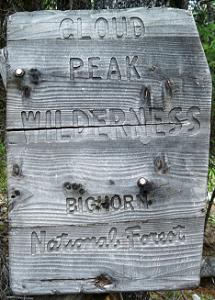 This is the Cloud Peak Wilderness boundary marker, but it could be any wilderness area. We have special regulations and laws when you set foot past that sign. It's necessary because many people still do not appreciate the value of preserving wild spaces.
This is the Cloud Peak Wilderness boundary marker, but it could be any wilderness area. We have special regulations and laws when you set foot past that sign. It's necessary because many people still do not appreciate the value of preserving wild spaces.I'm a pretty strong advocate for the concept of Leave No Trace even though the it's an impossible goal - we always leave some trace as we go through life. I guess I prefer the term Minimize Impact better since I can be successful at that.
Whatever you call it, I think it's important that the Boy Scouts put more effort into integrating and embracing LNT principles. It now appears on many pages of the latest Scout Handbook and is required knowledge and practice for advancing to First Class. But, I wonder how much it is actually promoted and checked for when those requirements are signed off.
Some people feel that Leave No Trace is just for wilderness areas and it's ok to hack, slash, burn, and trample BSA camps. BSA camps that I've visited are great places, but they get a lot of traffic. And, a couple uneducated scouts with a saw, ax, or shovel can do a lot of damage - damage that visitors will see for years.
These BSA camps are perfect training grounds for teaching and practicing how to minimize impact so that treks to Philmont, Northern Tier, or other wilderness areas are demonstrations of skill rather than learning of skill. They aren't wilderness areas, but they'll do just fine for learning. It's not appropriate to take youth to the wilds and then start explaining what Leave No Trace is and how to do it. That should have been done since they first joined the troop so they're ready to make the right environmental decisions on treks.
Making Leave No Trace happen depends highly on the adult leaders and traditions of a troop. If a troop has always had campfires, bathed in streams, tossed out or buried food waste, set up tents on the softest grass, ... then there is a big culture shift needed before they participate in a high adventure trek.
On the other hand, scouts that are used to using backpacking stoves, compressing and carrying out garbage, looking for durable spots for tents and kitchen, digging catholes, and the like will more likely have little problem completing a trek with small sign of their passing.
Our troop is fortunate to have a Leave No Trace workshop offered at least twice a year. From this, we've got a majority of scouts and adults trained in the principles. Having the knowledge makes the practices easier to incorporate into weekend campouts. Scouts look for good tent locations, stay on trails, are careful with food and pick up what they drop, strain wash water, just as a matter of course. Of course, they aren't perfect about it but we practice it and by the time they are old enough to go on any wilderness outing, they have the skills.
Please consider how your troop impacts the wilds. Check with your Council Outdoor Ethics Advocate to arrange a Leave No Trace workshop or see if you can get a scout and an adult to attend a Leave No Trace Trainer class. If you have an LNT Trainer, then he can present workshops to your troop, Webelos dens, Girl Scout troops, and any other groups heading outdoors. A Leave No Trace workshop isn't sitting and learning - it should be very interactive, hands-on activities that support the seven principles and I think they are a lot of fun, whether participating or presenting.
Scout On
| Leave Comment |
Posted: 16:56 08-16-2010 515
Mt. Rushmore Flag
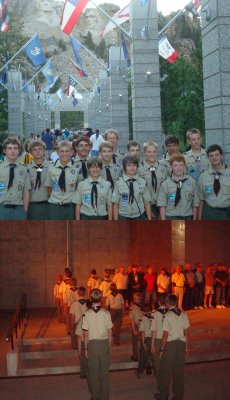 On July 31, the two backpacking crews met at Mt. Rushmore. One crew had just completed it's trek while the second was just beginning. It was interesting to see the 'enthusiasm' of one group and the 'experience' of the other when they got together.
On July 31, the two backpacking crews met at Mt. Rushmore. One crew had just completed it's trek while the second was just beginning. It was interesting to see the 'enthusiasm' of one group and the 'experience' of the other when they got together.After making dinner at the campsite, we arrived at the monument with just enough time to prepare for the evening ceremony. That was disappointing since most of us would have liked to explore a little.
The Ranger discussed the program with the two crew leaders and they walked the gang through the process a couple times. Then, we waited for the ampitheater to fill - and it sure did fill! You can see there was a stage full of Veterans and over 2,000 others in attendance. We met a troop from Los Angeles and a Cub Scout that can hardly wait to join a troop.
To start the program, our SPL led the audience in the Pledge of Allegiance. We then listened to the ranger speak and watched a video. At the end, it was our time to lower the flag.
It went well and each scout did their bit. The SPL gave commands, one scout lowered the flag, each scout held it tight, and a couple folded it.
We hung around about 15 minutes after the ceremony to let all the traffic clear out and then headed to camp to rest up before our long drives the next day - home or to the wilderness.
We stayed at Kemp's Kamp in Keystone, SD which is a very convenient spot for accessing Mt. Rushmore.
If you're interested in lowering the Mt. Rushmore flag, visit Mt. Rushmore homepage and complete an application in January - it fills fast.
Scout On
| Leave Comment |
Posted: 16:21 08-13-2010 514
New Outdoors Awards
 Three new awards for recognizing scouts that really get outdoors are available this summer. Or, I guess you could say it's seven awards.
Three new awards for recognizing scouts that really get outdoors are available this summer. Or, I guess you could say it's seven awards.The National Outdoor Badges recognize a scout's expertise and participation in five categories: Camping, Hiking, Aquatics, Riding, and Adventure. A scout earns the core patch and a segment, then can add the other four segments over time or concentrate on a single category and add gold and silver devices for additional participation.
When a scout accomplishes enough of the Outdoor Badges and wants to push himself a little more, he can earn the National Outdoor Achievement award. Recognition for this award is a medal. I like the requirements of Wilderness First Aid and Leave No Trace training, since that knowledge is vital for the other planning and leading requirements.
Finally, the unit can earn a streamer for its flag by completing the National Outdoor Challenge. The requirements are pretty substantial, requiring summer camp, merit badges, Leave No Trace program, and interaction with Webelos.
I don't know is where this blob of patches, segments, and pins is supposed to go. I suppose it's centered on the right pocket, but I'm pretty sure a plastic patch holder isn't going to cut it. Lots of troops already have segmented patch systems from summer camp on their right pockets - we do anyway.
Scout On
| Leave Comment |
Posted: 16:05 08-12-2010 513
Top of the World
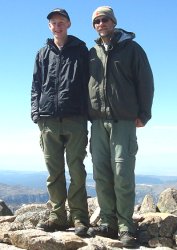 Preparation, perseverence, and perspiration pay off!
Preparation, perseverence, and perspiration pay off!At 13,167 feet, the top of Cloud Peak offers a breathtaking view in all directions of the Big Horn mountains and lands far off in the distance.
The climb up took almost six hours. For the first four and a half hours, the top had clouds rolling across so we did not know if we could make the summit. Finally, the sun won the battle and burned off the moisture, resulting in the most fabulous views I've yet seen from Cloud.
We started our ascent at 5:30am from 10,300 and gained almost 2,900 feet over rocks and boulders. The scramble up wears out your muscles, fighting against gravity and burning your energy reserves. Even though it is tiring, it is not as dangerous as the descent.
After enjoying the view for a half hour, the long climb down began. At first, it's easy with gravity helping you drop down the mountain. But, the pounding weight of your body dropping on each step can soon wear on your joints. The muscles fatigued from climbing up are less stable and steps are longer on the downhill.
Clambering down a rock slope requires care, concentration, and caution. Going uphill, there is very little momentum so a mis-step is more easily recovered. But, a downhill slip can mean a quick fall of a few feet and dire consequences.
Mountain climbers say reaching the summit is optional but getting home is not. That is a key thought I keep in mind all the time on treks. The mountain will be there tomorrow and next year. So, if the weather is bad, the people are worn out, or for some other reason, don't force the ascent - try it another time.
And, when you do reach the top - aaaaah! enjoy the view!
Scout On
| Leave Comment |
Posted: 23:30 08-10-2010 512
Mountain Rain
 Weather changes rapidly in the mountains. Having your raingear fast at hand is a critical bit of planning for wilderness treks to prevent soggy clothes and cold bodies.
Weather changes rapidly in the mountains. Having your raingear fast at hand is a critical bit of planning for wilderness treks to prevent soggy clothes and cold bodies.On this day, we arrived at our campsite just before big, black clouds rolled over the high peaks above us. We set up our tents and ducked inside just as the first drops started. After about 45 minutes of hard rain, the storm passed to the east, leaving this beautiful rainbow stretching across the canyon.
I left my tent as soon as the rain let up and was standing in our protected campsite watching the clouds roll away when the rainbow appeared. It was actually a double rainbow and the brightest I've ever personally seen.
The air was fresh, clear, and cool and I enjoyed a peaceful moment with no one else around, no sound but the wind and stream, and no cares or worries. A small treasure.
Scout On
| Leave Comment |
Posted: 20:53 08-09-2010 511
We're Back
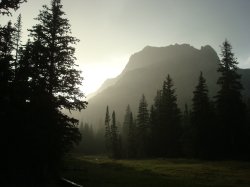 Two weeks and 80 miles of backpacking gets me back home where I started.
Two weeks and 80 miles of backpacking gets me back home where I started. I returned home with the second crew last night. Both treks were great experiences with their own challenges and rewards. One group made it to the top of Cloud Peak, the other was thwarted by lightning and hail. We found new spots to camp, a great new restaurant in Gillette, and successfully lowered the Mt. Rushmore flag.
I'll post more, so please check in daily. But, for now I've got 560 pictures to weed through and a couple thousand emails (yuch!).
The photo here was the end of an afternoon rainstorm in Medicine Cabin Park looking west. Wait until you see what I saw looking the other direction!
Scout On
| Leave Comment |
Posted: 15:50 08-08-2010 510
Trek On
The two crew leaders made their routes, menus, gear lists, and duty rosters. We have our tour permits, first aid training, and practice hikes complete.
Seven scouts and four adults will cover a 36-mile route and attempt to summit Cloud Peak at a bit over 13,000 feet. You can see the Crew #1 Route.
The next morning, I head back to Wyoming with the second crew of seven scouts and two other adults that has chosen a different 29-mile route but will also attempt to summit Cloud Peak. You can see Crew #2 Route.
The routes were made on Gmaps Pedometer which is a great place to make hiking routes, bike routes, or pretty much any route you need. You can view topo, satellite, or terrain. It is very useful for planning a trip and sharing your planned route with parents. Turning on the "elevation" is pretty neat too.
If you follow the route closely, you'll see an occasional squiggle of line (see mile 3 on Crew #1's route). These are spots where we plan to camp. I've not figured out how to place markers yet - anyone have advice on that?
We will have our SPOT Messenger along and I plan to turn it on every morning while we hike. If you feel like checking in on us to follow our progress, see our Real-time Tracking starting Sunday, July 25.
Scout On
| Leave Comment |
Posted: 7:14 07-24-2010 509
Good Jambo 2 U
Posted: 7:57 07-23-2010 508
A Week at Camp
Our week at Many Point summer camp was great! We had 46 scouts enjoy an amazing week of sun, wind, and one night of storms.
On Tuesday night, we were evacuated to the storm shelter for a couple hours. It was quite an event. The staff put in extra effort leading rousing songs for quite awhile. Turned out to be very little weather to actually hit the camp, but we were up very late.
Then, at around 5:30 on Wednesday morning, deja-vu all over again. This trip to the shelter wasn't so much fun. Looking over the lake from our campsite, I could see a wall of white rain moving towards us so there was a bit more urgency. No songs that early in the a.m. :-) Just waiting for the "all clear" which came about 7am.
Two tents and a pop-up shelter got whomped by the high winds, but that was all. After that, the weather was beautiful all week.
I had the most fun I can recall at camp on Friday afternoon when we sailed for 2 hours. I had two new scouts with me and they were pretty nervous about sailing for the first time ever so they wanted to go with someone experienced. I told them I've sailed a lot. I've had my own sailboat since I was younger then them. I sailed practically every day when I was a kid. And, I never tipped over unless it was on purpose. Even when I made big waves in the tub, that sailboat of mine didn't tip. :-)
But, they went out with me anyway and it was a blast. The daggerboard was whistling we were going so fast and at such an angle. One of them did slip overboard once but we wheeled around and picked him right up. Then, the other kept asking to go overboard and finally couldn't resist when we were on our way back in and "fell" over the side. I let him swim the rest of the way in as a "punishment".
Oh yeah, we did have 6 new scouts get a 12-hour bug that really cleaned out their systems (if you know what I mean) and then they were just fine. All in the same patrol, tentmates, one right after another for 4 days. One guy lucked out and didn't get it - even though he was sleeping between two that did.
We've got our campsite for next year reserved and it's a great one! Room for more scouts and close to the action - I'm looking forward to it already.
Scout On
On Tuesday night, we were evacuated to the storm shelter for a couple hours. It was quite an event. The staff put in extra effort leading rousing songs for quite awhile. Turned out to be very little weather to actually hit the camp, but we were up very late.
Then, at around 5:30 on Wednesday morning, deja-vu all over again. This trip to the shelter wasn't so much fun. Looking over the lake from our campsite, I could see a wall of white rain moving towards us so there was a bit more urgency. No songs that early in the a.m. :-) Just waiting for the "all clear" which came about 7am.
Two tents and a pop-up shelter got whomped by the high winds, but that was all. After that, the weather was beautiful all week.
I had the most fun I can recall at camp on Friday afternoon when we sailed for 2 hours. I had two new scouts with me and they were pretty nervous about sailing for the first time ever so they wanted to go with someone experienced. I told them I've sailed a lot. I've had my own sailboat since I was younger then them. I sailed practically every day when I was a kid. And, I never tipped over unless it was on purpose. Even when I made big waves in the tub, that sailboat of mine didn't tip. :-)
But, they went out with me anyway and it was a blast. The daggerboard was whistling we were going so fast and at such an angle. One of them did slip overboard once but we wheeled around and picked him right up. Then, the other kept asking to go overboard and finally couldn't resist when we were on our way back in and "fell" over the side. I let him swim the rest of the way in as a "punishment".
Oh yeah, we did have 6 new scouts get a 12-hour bug that really cleaned out their systems (if you know what I mean) and then they were just fine. All in the same patrol, tentmates, one right after another for 4 days. One guy lucked out and didn't get it - even though he was sleeping between two that did.
We've got our campsite for next year reserved and it's a great one! Room for more scouts and close to the action - I'm looking forward to it already.
Scout On
| Leave Comment |
Posted: 17:37 07-22-2010 507
Let's Be Careful Out There
When teaching Outdoor Leadership Skills for new scoutmasters, I try to drive home the Buddy System. I often say that I've not heard of TWO scout getting lost, it's always ONE that gets in trouble.
Now, I can't say that any more. Here are reports of two scouts, an adult leader, and even an entire crew of scouts getting lost in the past few days.
As you prepare to enjoy the outdoors this summer, please take time to really prepare!
Some important reminders:
In the News:
Scout On
Now, I can't say that any more. Here are reports of two scouts, an adult leader, and even an entire crew of scouts getting lost in the past few days.
As you prepare to enjoy the outdoors this summer, please take time to really prepare!
Some important reminders:
- Stay together - don't split a crew to take separate routes.
- Navigation - everyone has and knows how to use a compass. Everyone can tell direction without a compass.
- Buddy System - no one, not even leaders, go off on their own.
- Be Observant - continually notice weather, terrain, and crew members.
- Experience - know the area and have experienced adults before taking scouts on an adventure.
- 10 Essentials - everyone needs a small pack with important gear, just in case.
In the News:
- Two Scouts Lost - WA, adults let two scouts take a separate route from the rest of the group and they got lost.
- Two Scouts Missing - CA, scouts wander from camp.
- 23 Scouts Lost - WA, an entire group of scouts and adults take a wrong turn and are lost overnight.
- Leader Gets Lost - WA, scout leader from MN spends night alone on Mt. St. Helens.
Scout On
| Leave Comment |
Posted: 7:44 06-27-2010 506
Hiking merit badge
 I'll be taking two crews into the Cloud Peak wilderness of Wyoming this summer to experience some changes in attitude brought on by changes in altitude.
I'll be taking two crews into the Cloud Peak wilderness of Wyoming this summer to experience some changes in attitude brought on by changes in altitude. To prepare, the scouts have made a schedule of practice hikes and the two crew leaders have agreed on a minimum participation expected of each scout. Since we're hiking so much anyway, five scouts have started the Hiking merit badge. I love this badge! It's a great way to get guys out and moving for at least 70 miles over the summer.
We've got nine 10-mile hikes planned and we just completed one this morning. It's up to each scout to decide which hikes he'll go on and make his Trip Plan for each one and a Trip Report after each. Our 20-miler will be done after our trek to WY.
The scouts are using a great little tool at GMap Pedometer to lay out, save, and distribute their hike route. I get to see that it is safe and we all know right where we're going.
On our next hike, I'm going to take our SPOT Messenger so parents can monitor our progress and see when we're close to 'home'. I'll also send out an "OK" message about 20 minutes from the end so parents are at the pick-up spot on time. It's just practice for when we go on our real trek, and a fun use of technology.
See Hiking merit badge page for requirements and Trip Plan template.
Scout On
| Leave Comment |
Posted: 15:50 06-19-2010 505
Previous PostsComments:
Feb 25, 2023 - Joe Patterson
Just out of curiosity, are the Rockwell paintings on exhibit anywhere
Mar 16, 2023 - Adam John
Great question Joe! Have you checked out the Norman Rockwell Museum in
Stockbridge MA? (nrm.org) There is also the Rockwell Museum in Corning
NY. (rockwellmuseum.org) I believe the latter has more art. Hope this
helps!
Jan 21, 2024 - Johnna Downing
The Scouting museum at Philmont, Cimmaron, NM hopefully has the ones that
used to hang at the museum in Irving, TX. Good luck. Johnna
Scouting 2024 - Ask a Question - Add Content
Just for Fun: Socializing merit badge




This site is not officially associated with Scouting America
Find more Scouting Resources at www.BoyScoutTrail.com



Follow Me, Scouts
Recent Comments